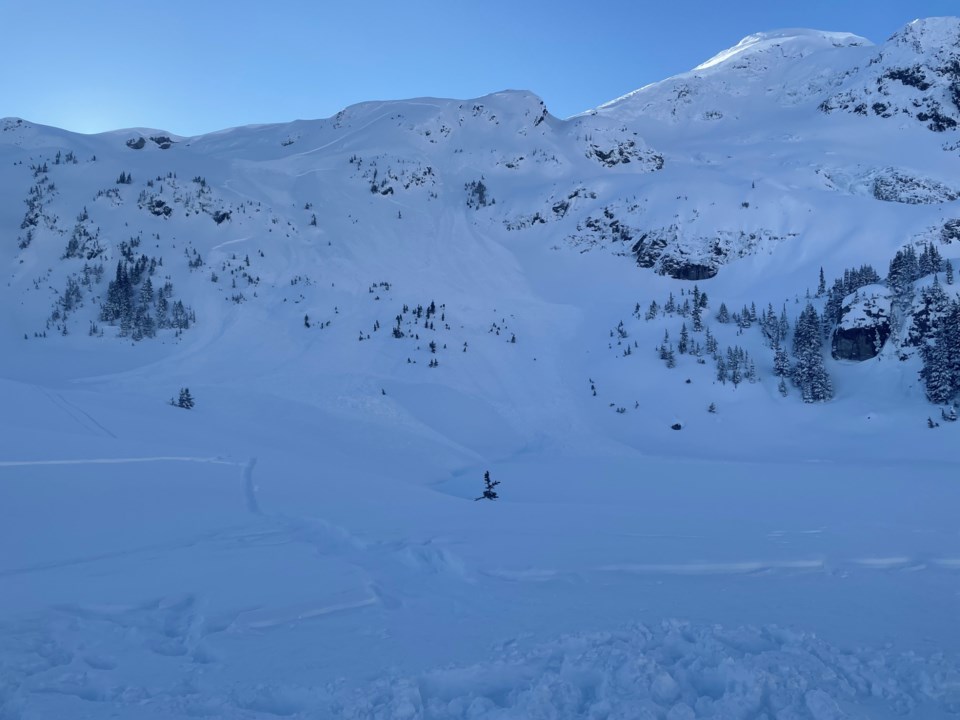Five local skiers were rescued after three members of their group were injured in a size 2.5 avalanche that released on Rainbow Mountain Tuesday morning.
According to a release from Whistler Search and Rescue (SAR), crews were called to the area at about 10:30 a.m. on Feb. 1 in response to reports of injured ski-tourers in need of medical evacuation.
Whistler SAR said the group had been heli-dropped at the top of a nearby run earlier that morning. They were in the process of skiing a second lap on a large, north-facing slope when the incident occurred at about 1900 metres of elevation.
All five skiers dropped in, one at a time, at the same spot on a convex slope, the release explained. Four skiers had already entered the slope and were reportedly resting on two natural benches on the mountainside as the fifth member of the group prepared to make their first turn. That skier appears to have initiated the slide, but managed to self arrest at the fracture line, said Whistler SAR, and was not caught in or injured by the avalanche.
Whistler SAR said one skier in the avalanche path attempted to "straightline it" towards the flats and successfully outran the slide.
The same can't be said for the remaining three members of the group. A second skier was caught up mid-path and came to rest on a bench after suffering lower leg injuries, while two more skiers were swept up and carried the full length of the approximately 500-metre slide.
Both managed to self-extricate from the toe of the slide after suffering "near complete burials," with just their heads left above snow. The skiers were flown by helicopter to a waiting ambulance and subsequently brought to the Whistler Health Care Centre for treatment of "chest injuries and other injuries," said Whistler SAR.
Crews opted to rescue the injured skier who was caught mid-path via helicopter longline, due to lingering overhead hazards.
Twelve Whistler SAR volunteers attended the scene. Whistler Blackcomb Mountain Ski Patrol's Rapid Intervention Team was also deployed on-site, so "in the event that if something further might have occurred, help was close by."
Whistler SAR manager Brad Sills said he's noticed a troubling trend emerging this winter, where the volunteer agency's call volume seems to increase when Avalanche Canada's public bulletin rates the Sea to Sky corridor's avalanche risk as "considerable."
"We would like to remind everyone that this designation should not be construed as a safe or medium risk, in that, within the definition, it clearly states that human triggered avalanches WILL occur," Sills explained.
According to Avalanche Canada, the slide on Rainbow Mountain broke 40 centimetres deep and ran on the facet-crust layer formed in late January. It "propagated across adjacent roll-over features and triggered a sympathetic slide on a small feature 200 m away," forecasters wrote in Wednesday's bulletin.
The Tuesday morning avalanche came following reports of "numerous large (size 2-2.5) human and explosive-triggered avalanches" the day prior that mostly broke between 20 and 50 cm deep.
But "In a few areas, these slabs broke 70-100 cm deep," Avalanche Canada's bulletin adds.
The Sea to Sky's snowpack picked up 30 to 50 cm of new snow over the weekend—much of which has since been redistributed into wind slabs across a range of aspects at upper elevations—that now sits on what forecasters call a "problematic layer combination." It's caused by weak, sugary facets that formed during a prolonged dry period over a thick melt-freeze crust.
"This late January facet-crust layer has demonstrated continuing reactivity in the aftermath of the weekend storm," explains Avalanche Canada's Wednesday bulletin, adding that backcountry travellers have reported remote-triggered avalanche activity, widespread whumpfing on this layer and reactivity in snowpack tests.
Those heading out into the backcountry are urged to monitor for changing slab conditions while moving into wind-exposed terrain.
Deeper in the snowpack, another crust layer can possibly be found buried 100-200 cm down. "This layer is most prominent between 1700-2100 m [of elevation] and is currently classified as dormant; although large loads such as a cornice failure or avalanches in motion may still be able to trigger avalanches on this layer," forecasters explain.
With five to 10 more centimetres of snow expected to fall over Sea to Sky peaks in the next 24 hours, the region's current avalanche danger rating for alpine terrain is listed as "moderate" for Thursday, before bumping back up to "considerable" on Friday.
That said, avalanche forecasters describe their confidence in the accuracy of these predictions as low. "Uncertainty is due to the fact that persistent slabs are particularly difficult to forecast," the bulletin explains.



.jpg;w=120;h=80;mode=crop)
